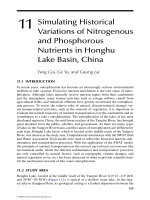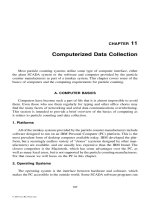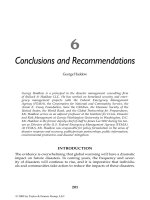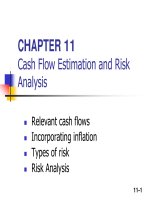GIS for Coastal Zone Management - Chapter 11 pdf
Bạn đang xem bản rút gọn của tài liệu. Xem và tải ngay bản đầy đủ của tài liệu tại đây (239.33 KB, 12 trang )
CHAPTER ELEVEN
Towards an Institutional GIS
for the Iroise Sea (France)
Françoise Gourmelon and Iwan Le Berre
11.1 INTRODUCTION
As far as coastal zones are concerned, many challenges faced by the scientific
community and policy makers, planners and managers justify adoption of a
transdisciplinary approach based on bio-chemical, geophysical and socio-
economical factors (Burbridge and Humphrey, 1999). GIS are well-established
computer-based systems for storing, retrieving, analysing, modelling and
visualising the vast amounts of spatial data that may be collected by several
providers (Fabbri, 1998). Nevertheless, the implementation of a coastal database is
a complex process which requires institutional support to guarantee the
multidisciplinary approach, the sustainability of the project in terms of raising
funds and human resources, and to promote relationships with other institutions
working on the same area (De Sède and Thiérault, 1996).
The major pollution caused by the
Erika disaster, coupled with the
catastrophic storms which reached the Atlantic coastal zone at the end of 1999, has
led the French authorities to propose creation of a national coastal GIS. The
implementation of such a project is complex, witnessed by the lack of any decision
about which reference geographical data for the coastal zone to adopt (Allain
et
al.
, 2000). In fact, coastal data are scattered among many organisations. They are
produced for lots of purposes and therefore are available at various scales,
typologies and formats. In spite of these difficult conditions, there are a number of
smaller, independent GIS projects at work on the French coastal zone
(ENR/OELM, 2000; Guillaumont and Durand, 2000).
This contribution describes the GIS implemented by Géosystèmes laboratory
(CNRS, European Institute for Marine Studies) on the coastal zone of Finistère
(western Brittany, see Figure 11.1) during the last ten years. In the beginning, the
GIS was conceived as a support tool for monitoring and managing the Biosphere
Reserve of Iroise, but today, it also serves as a powerful tool for carrying on
integrated research on the coastal zone of the Iroise Sea, especially within the
framework of the European Institute for Marine Studies (Institut Universitaire
Européen de la Mer, IUEM). This latter institute brings together a number of
© 2005 by CRC Press LLC
separate marine research teams from the University of Western Brittany, Brest,
dealing respectively with oceanography, geology, biology, chemistry, geography,
economy and law. The development from a GIS dedicated to scientific applications
towards an institutional support is described below.
Figure 11.1 Study area
11.2 THE DATABASES
Nowadays the GIS supports two complementary databases, called
SIGouessant
and
BIGIroise, that were originally developed with separate objectives and data
(see Figure 11.2).
The
SIGouessant database deals with the Mer d’Iroise Biosphere Reserve at a
local scale. The biosphere reserve label is allocated to representative terrestrial and
coastal areas by the UNESCO Man and Biosphere (MAB) programme. The
conception of such an area is based on three main functions: conservation of
biodiversity and landscapes; sustainable use in regional units; and logistic support
for research, monitoring, education, information and involvement of the local
population. In this context, many thematic studies have been performed on the Mer
d’Iroise Biosphere Reserve to increase knowledge of dynamic terrestrial and
marine processes, and to study the aftermath of human activity such as tourism,
management and fishing on biodiversity. The objectives are to provide a basis for
land management recommendations as well as for wildlife management
© 2005 by CRC Press LLC
programmes. The SIGouessant database has been developed since 1990 as a
support to the long term ecosystemic approach, and to provide data for scientific
and management investigations (Gourmelon
et al., 1995). The geographic
reference data is provided by orthophotographs produced by the French National
Geographical Institute (IGN - Institut Géographique National). The thematic layers
describe physical, natural and social parameters with the same classification
systems and scales, collected at various dates thanks to continued monitoring.
Figure 11.2 Database organisation
The
BIGIroise database is an extension of SIGouessant to the whole coastal
area of the Iroise Sea. Its initial aims were to produce a synthetic environmental
© 2005 by CRC Press LLC
mapping through combination of multiple data sets available for the coastal zone
(Le Berre
et al., 2000). The database uses marine geographical information
produced by the French hydrographic service (SHOM – Service Hydrographique
et Océanographique de la Marine), and is built up according to the environmental
planning methods developed and proposed by the Unesco MAB committee
(Journaux, 1985). After the collection of existing digital data, and the digitisation
of other data sources (atlases, maps, etc.), 34 thematic layers, concerning physical,
biological and socio-economical parameters for marine and terrestrial areas of the
Iroise Sea have been integrated in the GIS (see Figure 11.2).
After ten years of functioning, this GIS has become an adopted tool for data
inventory, environmental analysis and decision-making, which have been
described by Crain and Mc Donald (1984) as three development stages of a GIS.
11.3 OVERVIEW OF IROISE GIS APPLICATIONS
11.3.1 State of the knowledge
After the development of a set of tools for data processing and analysis, using
techniques such as association, combination and generalisation, the resulting
databases have been used to compile a baseline assessment of the state of
knowledge regarding the marine and terrestrial environments of the Iroise coastal
area. This has allowed the production of an atlas for public communication
(Gourmelon
et al., 1995), and the creation of a synthetic map showing the potential
conflicts of interests in the Iroise Sea (Le Berre, 1997). These documents are used
to support discussions among the stakeholders.
However, this inventory of existing knowledge also shows that the quality of
available data is heterogeneous
especially in terms of exhaustiveness and age
though strong efforts to collect and structure data on the Iroise Sea have been
made by a number of scientific and institutional organisations. One of the main
difficulties lies on the compatibility of marine and terrestrial geographical
reference data. Although the compatibility is essential for database coherence, we
are still waiting for a national consensus (Alain
et al., 2000) on this issue. Other
difficulties come from the lack of knowledge about the marine environment. The
structure and the functioning of the Iroise Sea ecosystem remains barely
understood. Moreover, except for some legal aspects, scarcely any geographical
information dealing with human activities is available.
GIS offers many functions that may be used to bypass these problems: For
example, the database can help define sampling strategies to be used for collecting
additional marine biological data; and it may also provide relevant data for the
implementation of theoretical models of ecological population distribution, based
on the applications developed for the US Gap Analysis project (Davis
et al., 1990).
The population models used for Iroise Sea are based on physical parameters such
as bathymetry, sedimentology, and hydrodynamic features (marine currents and
waves) and have been tested successfully on seaweeds and on the bottlenose
dolphin (
Tursiops truncatus, see the next section, below). Furthermore, integration
© 2005 by CRC Press LLC
with remote sensing allows the production of synoptic and multi-temporal data that
are particularly useful for marine studies, because of the variety of the sensors used
for recording parameters such as water colour, sea surface temperature, shore
morphology, etc. (Van Zuidam
et al., 1998).
11.3.2 Environmental issues
GIS is now widely used for applications relating to terrestrial studies and
management issues. In landscape ecology especially, the capabilities of GIS are
successfully used to perform spatial and statistical analysis of many environmental
components, and for modelling real-world processes (Haines-Young
et al., 1993).
In the islands and the islets of Iroise Sea, many similar GIS applications are
concerned with exploring relationships between vegetation and land-cover
changes, fauna (rabbits and nesting birds) and human activities. For example, land-
cover and land-use changes of Ushant island over a 150-year timeframe have been
studied, using field studies, aerial photographs and the 19
th
Century land registry
(Gourmelon
et al., 2001) as primary sources of data. Over this period, the island
underwent a drastic transformation from rural landscape to extensive shrubland.
Only traditional extensive sheep breeding is actually maintained. Within a GIS
analysis, the relationships between sheep grazing and land-cover have been
established, and scenarios of land-cover potential related to changes in the
intensity of sheep grazing produced. The scientific results have provided an
objective framework for further assessment of fallow land management.
Figure 11.3 Investigating factors influencing spatio-temporal distribution of bottlenose dolphin
(Tursiops truncatus)
In contrast to these successes on-shore, the implementation of GIS is more
difficult in the marine environment due to the peculiarities of maritime space-time
© 2005 by CRC Press LLC
scales, which tend to be generally wider, more complex and less well-known than
those of terrestrial ecosystems. A regional approach to marine environments is
often required, and data collected at several spatial and temporal scales need to be
integrated, for example data relating to the dynamic component of biological and
hydrological parameters that may occur daily (like tides), seasonally or annually
(like lunar and biological cycles), or that may only be noticeable over several years
and decades, such as long term changes (Holligan, 1994). This complexity implies
a need to link the GIS to models for the production of dynamic data, i.e.
hydrodynamic modelling, and for the analysis of the functioning of the whole
system and its subsystems (Capobianco, 1999).
As has already been mentioned above, within the Iroise Sea one area of data
analysis aims to investigate the environmental factors that may influence the
spatio-temporal distribution of the bottlenose dolphins (see Figure 11.3). In
France, the increasing interest in natural heritage has encouraged development of
resource management efforts that maintain a high degree of biodiversity. In this
context, a Marine National Park project has been proposed for the Iroise Sea,
which would include both the areas of coastal bottlenose dolphins. A spatial and
temporal approach to the dolphin habitats is required to define a conservation
strategy based on habitat features, more than on spatial distribution of groups.
Such an approach has been developed in the United States through the Gap
Analysis Program conducted by the U.S. Geological Survey (Davis
et al., 1990),
and is being adapted for the Iroise Sea. Within this wider framework, a more
localised study is focusing on a particular group of dolphins observed around Sein
Island, and which has been monitored since 1992 (Gourmelon
et al., 2000). The
annual and seasonal distributions of this dolphin group reveal some preferential
sites inside its vital area. Investigating the factors leading to this perceived spatial
determinism requires that spatio-temporal parameters be considered, and is thus
well-suited to GIS analysis. Meanwhile, at a more regional spatial scale, a
classification of bathymetric parameters has been performed to produce a sea-floor
stratification that may be compared to observations of bottlenose dolphin
distributions (Le Berre
et al., 2002). At both scales, local and regional, strong
relationships appear between bottlenose dolphin distribution and topographic sea-
floor features. The GIS is subsequently used for dolphin habitat suitability
modelling, based on logistic regression. This methodology provides a means of
mapping the dolphin distribution, and providing useful information for the future
National Marine Park. Nevertheless, distribution of prey with depth of slope and
hydrodynamic activity is probably of prime influence. The next step of this
research will be the introduction of physical and biological modelling in the GIS.
The synergy between numerical models and GIS is necessary for the production of
dynamic data useful in such an investigation.
11.3.3 Contribution to integrated coastal zone management
A large part of the Iroise coastal zone belongs to protected areas of various types
(natural reserves, hunting reserves, biosphere reserve, proposed national marine
park, etc.) for which there is a strong need for scientific long-term monitoring, and
also of concrete strategies and policies for management. In such contexts, maps are
© 2005 by CRC Press LLC
essential, both for decision-making by field staff, and also for information
communication aimed at the stakeholders involved (decision-makers, managers,
scientists, etc.). The integration of data from various sources within a consistent
framework, as provided by a GIS, improve their accessibility and their availability.
GIS also provides efficient functions for rapid production of thematic or synthetic
maps and other visualisations, designed for different purpose. Above all, GIS
shows great potential for the design and the production of good quality maps
tailored to specific uses, such as decision-support during a specific critical event
such as an oil-spill, particularly if the mapping process is automated. For instance,
in the environmental monitoring programmes implemented for the Iroise sea, the
GIS is used for the preparation of sampling strategies, for the detection of spatial
changes, for the assessment of future evolution, and for impact simulations.
The assessment and simulation of impacts or changes that affect coastal areas
are generally made within the scope of management strategies and policies
(Capobianco, 1999). Spatio-temporal modelling, coupled with geographical
databases may be very efficient for the production of realistic syntheses of an
ecosystem’s evolution after different disturbances. In such an integrated and
multidisciplinary context, the design of operational tools for decision support
depends on the upholding of links between numerical geographical information
and other databases, on the integration of spatio-temporal modelling and on the
production of user-friendly interfaces that facilitate access to information.
In order to test the ability of
BIGiroise as an operational tool, the
geographical information available for the tidal zone of a limited part of the Iroise
Sea was used as a test bed for the development of a model dedicated to oil spill
contingency (Le Berre, 1999). It takes into account the relevant data for assessing
the sensitivity of coastal areas in order to prepare and to plan the strategies of
intervention and to provide useful information for the monitoring of damaged sites
(see Figure 11.4). In a practical way, shore sensitivity is assessed through morpho-
sedimentary, ecological and socio-economical indices (Michel and Dahlin, 1997)
but, for the production of a relevant information for operational needs, vulnerable
areas exposed to the pollution risk must be identified. The assessment of risk
requires that meteo-oceanic and physico-chemical features of the pollutant be
taken into account. This can only be achieved within a spatio-temporal model. In
this operational context, the GIS may provide information, especially maps, useful
for helping decision-making, but this is only a part of a more comprehensive
facility that should be implemented. An efficient system for such purposes requires
significant extensions such as oil spill drift models, links with thematic databases
(i.e. about pollutant composition) and the production of users interfaces (Howlett
et al., 1997).
11.4 PLAN FOR AN INSTITUTIONAL COASTAL ZONE INFORMATION
SYSTEM
The research programme described herein demonstrates the contributions and the
limits of the GIS implemented for the Iroise Sea. The major issues are now its
timelessness and the improvement of its ability to produce a better knowledge of
environmental and socio-economical processes in the aim to provide useful
© 2005 by CRC Press LLC
information for decision-making. It implies in a next step an integration into a
more efficient framework (see Figure 11.4). An integrated environmental coastal
zone management system, for assessing coastal zone changes and functioning,
should integrate remote sensing, modelling, GIS and GIS-based decision support
systems (Van Zuidam
et al., 1998).
Figure 11.4 Development of an operational GIS
11.4.1 Context and objectives
The GIS developed for the Iroise Sea is an essential component of the
infrastructure established to support environmental research programmes
conducted by the “Géosystèmes” laboratory. The GIS is used for scientific
analysis, to improve the protocols for field data collection, and in some cases to
provide decision-making information such as maps and statistics. Due to its
environmental characters, the Iroise Sea is the core area of most of these research
programmes, sometimes spanning several decades. A proposal has been submitted
by the component research units within the laboratory, to the national authorities,
to establish a Coastal Domain Observatory with the aim of recording and
monitoring long-term changes in a western European coastal area strongly
influenced by both climate fluctuations and anthropogenic impacts. The proposal is
currently undergoing evaluation for possible funding. In this context, a Coastal
Environment Information System (Système d’Information des Environnements
Côtière, SIEC) connected with an intensive computing centre is planned, to
reinforce the synergy of the Institute, especially by providing facilities for
gathering remote sensing data, image processing, GIS and dynamic modelling.
This common service will have five main functions:
© 2005 by CRC Press LLC
x Collection of data and integration of existing datasets produced by the
IUEM, concerning physical, biological and anthropogenic parameters,
and creation of a consistent GIS database, based on the geographical
reference information approved by the French National Committee for
Geographical Information (Conseil National pour l’Information
Géographique, CNIG, see );
x Develop and maintain global data exchange conventions in order to
make geographical reference information produced by organisations such
as IGN, SHOM, Ifremer or Météo-France available to the IUEM research
teams;
x Information production by the digitisation of maps, or by data
processing of numerical data (interpolation, image analysis, etc.);
x Metadata production for supplying a catalogue to assist internal and
external data exchange and diffusion between data producers
(laboratories, institutions) and users (laboratories, marine professionals,
policy and decision-makers);
x Education and training of the IUEM staff and students in Geographical
Information Sciences.
The feasibility of this joint project has been tested from an inventory of the
whole data produced in the IUEM research labs.
11.4.2 The first stage: data dictionary and metadata production
Within the IUEM, the needs for data cataloguing are both external and internal.
For internal uses, the maintenance of an up-to-date description of datasets is a
guarantee of its long-term viability, and may improve collaboration and exchanges
between research teams as it avoid redundancies in research projects. As a research
institute, IUEM is an important data producer and user, and has a strategic need for
being identified as a data provider by different kinds of external users, especially
in a context of the growth of data and information communication across the
World Wide Web. The Institute’s data broadcasting policy within the SIEC implies
a strong compliancy with existing metadata standards, in order to guarantee their
robustness and encourage their exchange (Bartlett
et al., 2000).
At present, two major metadata standards are used by the international
community of geographic information providers: the European standard (CEN/TC
287) and the International standard (ISO/TC211). Correspondence between these
two is not perfect, especially in terms of data ownership rights, but the general
hierarchical structure of the data descriptions allows the conversion from one
standard to the other. As the contribution and established collaborations of the
IUEM to international research programs takes place mainly at the European level,
the European standard has been adopted for SIEC. The metadata are integrated and
managed with Report V2.0, a CEN/TC287-compliant metadata software system
developed by the French Ministry of Equipment. At the laboratory level, although
the geodatabase was developed initially with ArcInfo software (where ArcCatalog
is compliant with the ISO standard), Report is also used for producing and
© 2005 by CRC Press LLC
managing the metadata catalogue until such time as ArcCatalog can take into
account the European metadata standard.
In fact, the conversion of standardised metadata to specific formats stays
unavoidable when supplying information to Web geodatabase repertories or
clearinghouses such as Bosco (, for French coastal data) or
EDMED ( for data produced
during MAST research programs) for example. The need to be able to undertake
this kind of specific task will be taken in account when developing the SIEC
structure.
11.5 CONCLUSION
The experience acquired after ten years of coastal GIS development shows that
even if the databases are useful in many scientific and management applications,
their prospects depend on a better standardisation of geographical reference data
and their metadata, and on a better integration of the GIS into environmental
coastal zone management systems. In the future, data collected and used in Brest
will be transferred into the SIEC, a coastal environment information system
planned at the IUEM level. In this long-term framework, specific funding and a
proper organisational context will be allocated to this information system.
Currently, the inventory of data available to the concerned laboratories, and the
metadata production, are continuing. The next steps of this joint project will
concern the design and the implementation of this multidisciplinary coastal GIS
(Muller
et al., 2000). From specific scientific applications, the GIS now has to
evolve towards an institutional system designed and developed by a team based on
future users and data providers.
11.6 ACKNOWLEDGEMENT
The authors would like to pay tribute to the late François Cuq, Director of the
Géomer (Géosystèmes in the past) CNRS laboratory and of the Coastal
observatory of the European Institute for Marine Studies, who died in May 2003,
for his strong involvement in the birth and the growth of a GIS team of
geographers in Brest, and for his huge contribution to the development of applied
geomatics to coastal zone management in France.
11.7 REFERENCES
Allain, S., Guillaumont, B., Le Visage, C., Loubersac, L., and Populus, J., 2000,
Données géographiques de référence en domaine littoral. In
Coastgis'99:
Geomatics and coastal environment
, edited by Populus, J. and Loubersac, L.
(Brest: IFREMER-SHOM), pp. 67-79.
Bartlett, D., Fowler, C., Longhorn, R., Cuq, F., and Loubersac, L., 2000, Coastal
GIS at the turn of the century. In
Coastgis'99: Geomatics and coastal
© 2005 by CRC Press LLC
environment, edited by Populus, J. and Loubersac, L. (Brest: IFREMER-
SHOM), pp. 307-318.
Burbridge, P. and Humphrey, S., 1999, On the integration of science and
management in coastal management research.
Journal of Coastal Conservation,
5, pp. 103-104.
Capobianco, M., 1999, On the integrated modelling of coastal changes.
Journal of
Coastal Conservation
, 5, pp. 113-124.
Crain, I.K. and Mc Donald, C.L., 1984, From land inventory to land management.
Cartographica, 21, pp. 40-46.
Davis, F.W., Stoms, D.M., Estes, J.E., Scepan, J., and Scott, J.M., 1990, An
information systems approach to the preservation of biological diversity.
International Journal of Geographical Information Systems, 1, pp. 55-78.
De Sède, M.H. and Thiérault, M., 1996, La représentation systémique du territoire:
un concept structurant pour les SIRS institutionnels.
Revue internationale de
Géomatique
, 1/1996, pp. 27-50.
ENR/OELM, 2000,
Diagnostic de territoire de la Côte d'Opale. Publication
Espace Naturel Régional / Observatoire de l'Environnement Littoral et Marin,
.
Fabbri, K.P., 1998, A methodology for supporting decision-making in integrated
coastal zone management.
Ocean & Coastal Management, 39, pp. 51-62.
Gourmelon, F., Bioret F., and Le Berre, I., 2001, Historic land-use changes and
implications for management of a small protected island.
Journal of Coastal
Conservation
, 7, pp. 41-48.
Gourmelon, F., Liret, C., and Bonnet, M., 2000, Approche géomatique de l'habitat
grand dauphin en mer d'Iroise. In
Coastgis'99: Geomatics and coastal
environment
, edited by Populus, J. and Loubersac, L. (Brest: IFREMER-
SHOM), pp. 186-197.
Gourmelon, F., Bioret, F., Brigand, L., Cuq, F., Hily, C., Jean, F., Le Berre, I., and
Le Demezet, M., 1995,
Atlas de la Réserve de Biosphère de la Mer d'Iroise :
inventaire numérique des milieux terrestres, intertidaux et marins
(Hanvec: Parc
Naturel Régional d'Armorique).
Guillaumont, B. and Durand, C., 2000, The integration and management of
regulatory data in a GIS: an applied analysis of the French coasts. In
Coastgis'99: Geomatics and coastal environment, edited by Populus, J. and
Loubersac, L. (Brest: IFREMER-SHOM), pp. 269-283.
Haines-Young, R., Green, D.R., and Cousins, S.H., 1993,
Landscape ecology and
GIS,
(London: Taylor & Francis).
Holligan, P.M., 1994,
Land Ocean Interaction in the Coastal Zone (LOICZ) :
Implementation Plan
. IGBP.
Howlett, E., Anderson, E., and Spaulding, M.L., 1997, Environmental and
geographical data management tools for oil spill modelling applications. In
Proceedings of the 20th Arctic and Marine Oilspill Program (AMOP),
Environment Canada, (Vancouver), pp. 893-908.
Journaux, A., 1985,
Cartographie intégrée de l'environnement un outil pour la
recherche et pour l'aménagement
. MAB-UNESCO, ed. UGI.
Le Berre, I., 1997,
Réserve de biosphère de la Mer d'Iroise : carte de synthèse
Conseil Général du Finistère
. MAB-UNESCO.
© 2005 by CRC Press LLC
Le Berre, I., 1999, Mise au point de méthodes d'analyse et de représentation des
interactions complexes en milieu littoral.
Thèse de Doctorat, Géographie, Brest,
UBO.
Le Berre, I., Gourmelon, F., and Liret, C., 2002, Modélisation bathymétrique de la
mer d’Iroise, application à l’étude du grand dauphin côtier.
Revue internationale
de Géomatique
, 12/2002, pp. 337-354.
Le Berre, I., Meyrat, J., and Pastol, Y., 2000, Application des données
hydrographiques à l'étude synthétique de l'environnement côtier: exemple d'un
SIG sur le littoral du Finistère (France). In
Coastgis'99: Geomatics and coastal
environment
, edited by Populus, J. and Loubersac, L. (Brest: IFREMER-
SHOM), pp. 233-244.
Michel, J. and Dahlin, J., 1997
, Guidelines for developing digital ESI atlases and
databases
. NOAA.
Muller, F., Donnay, J.P., De Cauwer, K., Schwind, L., Devolder M., and Scory, S.,
2000, Design of an oceanographic database. In
Coastgis'99: Geomatics and
coastal environment
, edited by Populus, J. and Loubersac, L. (Brest: IFREMER-
SHOM), pp. 124-133.
Van Zuidam, R.A., Farifteh, J., Eleveld, M.A. ,and Cheng, T., 1998, Developments
in remote sensing, dynamic modelling and GIS applications for integrated coastal
zone management.
Journal of Coastal Conservation, 4, pp. 191-202.
© 2005 by CRC Press LLC









